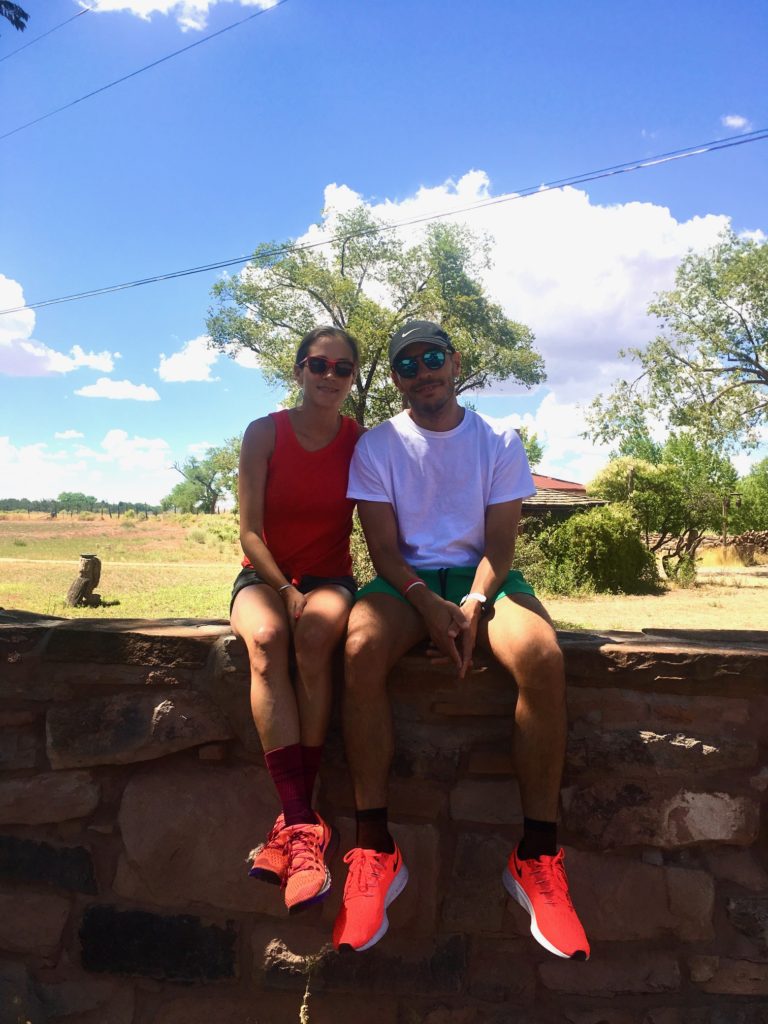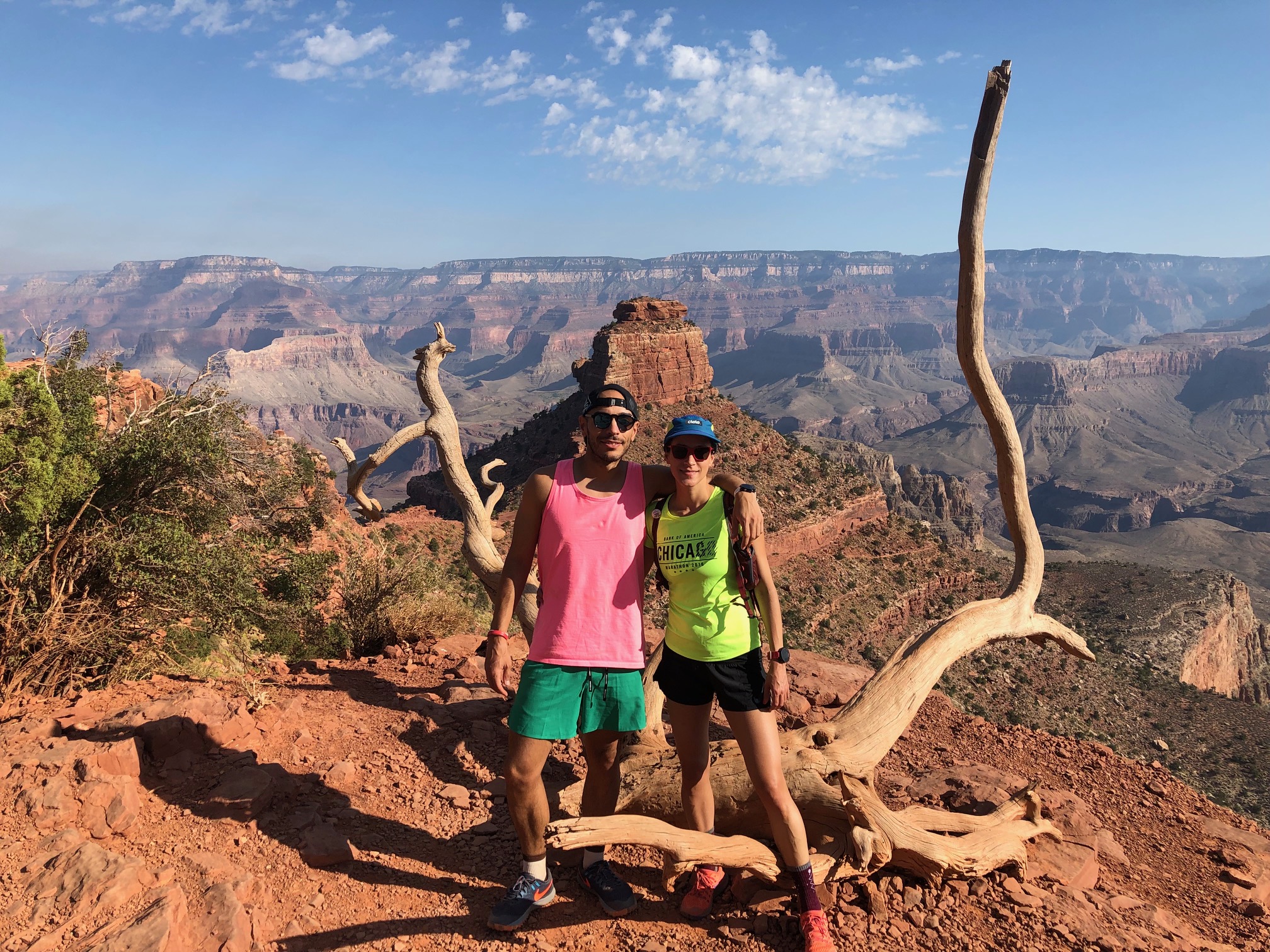In August, we took a trip to the Grand Canyon National Park. We drove out from Albuquerque, New Mexico with my cousins and enjoyed the desert views along the way. This was not my first trip to the Grand Canyon, but I was reminded (again) just how magnificent it is. Everyone should try to go at least once.
Located in Arizona, the Grand Canyon is a mile deep canyon over the Colorado River with an average width of ten miles across. It is an extremely popular (read: touristy) location, with visitors from all over the world. In fact, the Grand Canyon was the second most visited national park in 2019, with almost 6 million visitors. Over 90% of visitors head to the South Rim of the canyon, which has more options for lodging and amenities. The South Rim averages about 7,000 feet elevation above sea level.

TRIP PLANNING: BEFORE
I started looking into this trip about nine months out as I knew that the Grand Canyon is a highly visited national park. In the beginning I researched how we would best get there and where we would stay. I coordinated to go with my cousins from New Mexico and looked up campgrounds within the park. I booked my campsite in March for our late August trip. Due to the park’s popularity and high volume of visitors, it is essential to book your reservation ahead of time.
I decided on Mather Campground because it is on the South Rim of the park and close to many amenities. If you’re not into camping, there are a number of beautiful lodges within the park as well. You also have the option of staying outside the park, but you will have to contend with daily traffic to enter the park.
For transportation, I figured out that I would be driving in with my family from Albuquerque. You can also fly in to nearby airports and drive, such as Flagstaff (1+ hour), Phoenix (3-4hr) or Las Vegas (4-5hr).
Roadtrip: ABQ to Grand Canyon

We left Albuquerque in the morning and made our first stop at the Hubbell Trading Post to break up the 6+ hour drive. The Hubbell Trading Post is a national historic site in Ganado, Arizona that has been operating as a trading post of Native American art since 1878 and run by the National Park Service since 1967. After eating a picnic lunch there, we explored the grounds and museum collection. Then we got back on the road again.

Entering the Park
We entered the park from the southeast, passing through the nearby Hopi Reservation on smaller highways. As we gained elevation, we drove through the Kaibab National Forest, lush with ponderosa pine, fir and spruce trees. We drove through the forest for a while until we entered the park.
At the entrance, I bought the America the Beautiful pass. This pass grants me access to more than 2,000 federal recreation sites for a year. I got it knowing that I would be headed to more national parks on my California trip in December. You can also pay a one-time entrance fee. More basic information about the park can be found here.
Desert View Watchtower

After entering the park, we made our first stop at the Desert View Watchtower in the South Rim. The Watchtower was designed in 1932 by Mary Colter in the style of Ancestral Puebloan towers. There is an amazing viewpoint out towards the canyon from here, which gave us our first glimpse of the gigantic canyon and it’s sweeping beauty. The tower itself is quite impressive and you can climb all the way up to the top in a series of spiraling stairs.
Camping in the Grand Canyon

We camped in Mather Campground inside the park, which is on the South Rim and open year round. You can make reservations for the campsite up to 6 months in advance at Recreation.gov. The campground is in a great location and it has lots of trails around for short walks and hikes directly from the site. If you need to re-up on any groceries or supplies, the Grand Canyon Village is a short drive away.
Even though we were there in summer, the high elevation and desert environment made for quite chilly nights and mornings. Make sure to pack accordingly for both the heat and the cool evening temps. At night, you have amazing views of the bright stars and sky, being so far away from city light pollution.
Running in the Grand Canyon

As I mentioned, the South Rim sits at around 7,000 feet elevation, which is definitely something to be considered for any hike or run you do here. We did a long run on our first morning along the Rim Trail that traces the canyon’s edge. We started early to beat the heat and avoid the large crowds. Luckily, we could leave directly from our campsite on a smaller trail that linked up to the Rim Trail. The route consisted of a winding, paved trail with occasional water fountains and bathrooms.
It was definitely tough to run at elevation, and more difficult when combined with the heat in the latter part of the run, but we persevered. Either way, getting the opportunity to run along the canyon was easily one of the most epic runs I have ever done. Just taking in the panoramic views into the vast expanse of the canyon was something I’m not sure I’ll be able to top.

Hiking in the Grand Canyon

After our run along the Rim Trail, we set out on the free shuttle that stops at various locations around the park. We got off at Hermits Rest, the farthest western stop on the South Rim. We did a slow, easy hike from there to Pima Point and then hopped back on the shuttle. It was stunning to observe the sprawling canyon as we walked. Afterwards we met up with my cousins at the El Tovar Lodge for some ice cream and drinks. This is a nice place to chill after a hike.


There are tons of hiking options in the Grand Canyon, with most of the easier ones above the rim. For steeper and harder hikes you can venture down into the canyon, but you must be well prepared for those hikes. You can access many of the trailheads using the free shuttle bus that runs from sunrise to sunset. For the more adventurous, you can look into a backcountry permit to hike and camp down in the canyon. This gets booked up fast though, so you’ll want to start planning 9-12 months out.

South Kaibab Trail

On our second day we did an early morning hike on the South Kaibab Trail. We took the early morning Hikers’ Express Shuttle from the visitor center to the trailhead, which starts running earlier than the main shuttles. The goal is to start your hike before sunrise or just after to spend as much time as possible hiking in cooler weather. Since we were there in late August/early September, the days got very hot and we wanted to avoid the heat as much as we could.
It was cold when we started and we wore our long sleeves, but ended up completely stripping down to our t-shirts as the sun came out. We made sure to pack tons of water since there aren’t any water spots along the trail. We also wore hats, breathable clothing and sunscreen to protect ourselves from the sun.

Since we were doing a day hike, we went down about a mile and half to the second rest area called Cedar Point. It is not advised to go beyond this point if you are doing a day hike in summer due to the heat and potential for dehydration.

Planning Ahead When Hiking

It is crucial to plan ahead when hiking in the Grand Canyon. Due to the elevation, heat and exposed canyon trails, you will need to pack tons of water, as there is often only water available at the trailheads. Aside from water, pack snacks and weather appropriate clothing. The park promotes Hiking Smart, with the following guidelines:
- Plan your hike before you start.
- Balance your food and water intake.
- Eat salty snacks and drink water or sports drinks.
- Go slowly, rest often, stay cool. Allow the weakest hiker to set the pace.
- During the summer, hike during the cooler, shadier times of the day.

